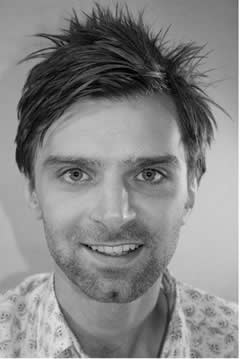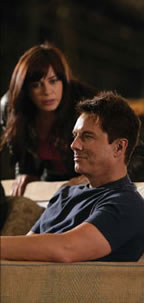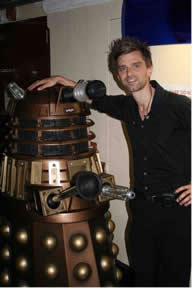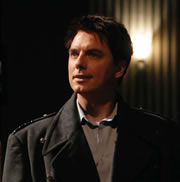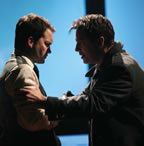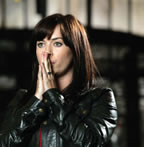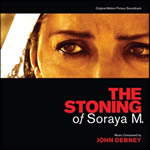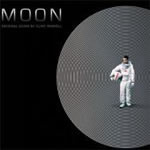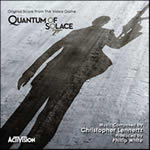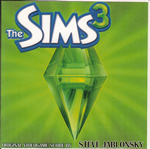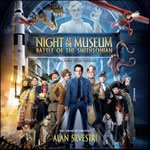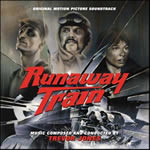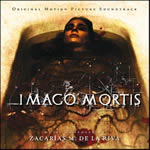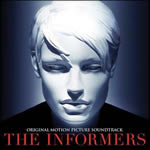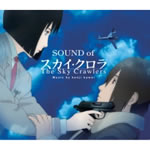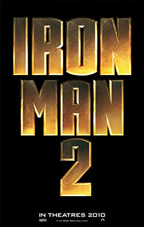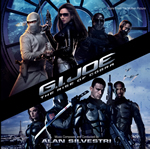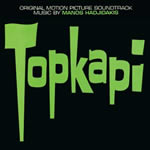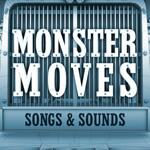 |
Soundtrax: Episode 2009-9
July 18th, 2009By Randall D. Larson
Ben Foster Carrying on the Torchwood
Ben Foster on Scoring Doctor Who and TorchwoodBen Foster is best-known for his work as orchestrator and conductor on Doctor Who and as composer for Torchwood. His work on Torchwood has earned him two nominations for best soundtrack at the BAFTA Cymru Awards. Ben started his Film & TV career with scoring over 30 short films for various European directors and subsequently writing for a variety of television programmes. Most recently he has worked as orchestrator and conductor on big budget films The Mummy 3 – Tomb of the Dragon Emperor, Glorious 39, Is Anybody There? and Hoodwinked 2. In May 2009 he conducted the London Soundtrack Orchestra in the first complete performance of Herrmann’s score to Psycho live with the film. Ben was chairman of the judging panel for BBC Young Musician of the Year 2008 and is a regular contributor to various programmes including Blue Peter and Clash for CBBC.
Interviewed via telephone on July 6th, 2009, Foster described his experiences in working on Doctor Who and Torchwood and the musical approach undertaken on both of these series.
Q: How did you get involved with Murray Gold and Doctor Who?
Ben Foster: I’d started orchestrating for other composers, and I worked on a couple of projects with a British composer named Joby Talbot, including The Hitchhiker’s Guide To The Galaxy. At the time, Joby’s agent, Catherine Manners, was also Murray’s agent, and so when there was an opportunity to use the orchestra for the second season of Doctor Who she had me in mind and introduced me to Murray. The first thing I did was way back in November of 2005, and that was the start of what’s been a pretty constant four years. I’ve collaborated with Murray since then on various projects including his feature film projects and other TV work. I’ve also worked with other composers here and in America. But Murray’s work has been my big focus, with Doctor Who six months out of the year for the last three seasons. Torchwood came up, way back in 2006 I think, and Murray naturally got asked to do that by Russell T. Davies the creator of Torchwood and Julie Gardner, the executive producer. But he felt it was going to be another big project to do, and he kindly asked me, “would you like to work on it with me, and maybe you could write a few bits and I could write some bits and we could share it?” And we did and it was great, it was such an opportunity for me. I was very lucky because Murray got busy with other things and he passed it over to me, and I took on the brunt of Series 1. Murray did the pilot and ep 4 and then I ran with the rest of it, and he did the first ep in Season 2 and we did half and half on the finale of Season 2, and then Season 3’s just been me, so it’s been a huge opportunity for me thanks to Murray’s generosity as a colleague and a friend.
Q: Certainly the original Doctor Who in the 1960s was very electronic and had a very different visual and sonic tone than this new version. How as the musical sound design established on the new Doctor Who?
Ben Foster: All of Series 1 was done, with the exception of some choir and a few solo instruments, synthetically, but to sound orchestral. Murray very skillfully used all the Vienna samples that were the latest thing at the time, and so he made that sound really big and orchestral, but purely with synths. After Series 1 did really well, it was a natural flow from that to say, “well, we’ve got a great opportunity to work with the BBC National Orchestra of Wales [BBC NOW], and they’re really keen to do it,” and that was when I came on board. Since then, when we’re going for the big orchestral sound, it’s all real. We also do recordings in London with a smaller ensemble when we can. I think Murray went for that orchestral sound straight off the bat at the top, because that was really what Russell T. Davies’s writing’s all about. It’s a sci-fi show but it’s about people, it’s about emotions, and the whole of Series 1 was about this girl, Rose, who met the Doctor and how her life was changed by him, so it’s a very human show. It was perhaps a little bit more way out and more of a purely sci-fi show in the early days, and that worked very well with the synthesized music, but then it was the late 60s, 70s, and there was very much a trend of using electronic music to sound otherworldly and very different. At this stage it’s quite in vogue to use an orchestra, and I guess we’re aiming to make the show sound expensive. People are so used to hearing big budget Hollywood films, and if we can get a TV show on prime time that looks and sounds up to that, it’s proven to bring in a huge audience. I think it’s wise to give the audience a familiar sound, I think people warm to that.
Q: Another thing that’s distinctive about both Doctor Who and Torchwood, while a lot of movies and certainly a lot of television is either electronic or it’s rhythm or beat based, both Doctor Who and Torchwood are filled with these lovely orchestral melodies.
Ben Foster: I love TV music, aside from film music itself, particularly the early work of Jerry Goldsmith and John Williams when they were doing all those amazing sci-fi shows from the early 1960s. There are composers over here like Ron Grainer or Laurie Johnson, who did TV shows like The Prisoner and The Avengers and those kinds of things, and they were all acoustic instruments. To me they have longevity and a deeper emotional level because of that, and that was something I wanted to continue. I’m also hugely influenced by Michael Giacchino, although I definitely try not to stylistically copy from him, but I’m impressed by the quality of his sound and his defiance in insisting on using live players. I guess we’re competing over here, in Britain, trying to get the shows to have a worldwide appeal, so we’re very much trying to pull ourselves to that “Hollywood” level. And, as you say, if you’ve got an emotional thing, I find that it’s very hard, as a composer, to do that with something that isn’t human. That was something early in with Torchwood that Murray and I decided with the producers, that there would be a mixture of electronic music and strings. The first thing we did was to have a string ensemble of twelve players, just because I thought we needed that sound, that quality and that emotional level. Electronic sounds are great for bringing things into a 21st Century kind of sound, but I think they lack something if that’s all you have, so I very much wanted to bring that emotion in. Torchwood has certainly changed over the first three seasons and it’s become something, particularly in Russell’s writing, it’s about the bigger picture, it’s about humanity. It’s not about funny creatures with green heads that come down and attack us, it’s about how we deal with that, as humanity, how we cope with that and what choices we make to defend ourselves. Particularly this new series, with Children Of Earth, what decisions as humans do we make to defend ourselves, and how far can you take that? I find that affects me deeply, and the music that comes out of that is true to the story.
Q: When you’re starting a new series, such as the current one, are you aware of the entire arc of that series, so you’re able to build your music from the first episode across that arc?
Ben Foster: Yes. On Series 3, there was an outline for the whole series and the scripts were pretty much set in place. The arc was very clear and I knew what was going to happen in the end. I did have a couple of clear months before it got crazy to spend working out themes that could become recurring themes throughout the five episodes. And when we did our first recording session for the first two episodes, I was able to record a bunch of themes which I had in mind to be used in episodes 4 and 5, because I knew there were some big events coming up. We rerecorded them for the actual production, but I had them in the bag so I could demo them for the producers. That was very helpful. I honestly think these series are so much fun as a composer because you have that chance to develop themes, you have that chance to drop in a few hints of a melody that has some significance before the audience is really aware of it. There’s a particular example in Episode 1 where I’ve dropped some hints of a melancholic theme that presages something that’s going to happen later on.
Q: Would you elaborate on the score’s thematic structure and how you’ve had to map out the various themes through each of the series?
Ben Foster: There’s a theme for the aliens, the 456, so I wrote a three-note theme, which is very clearly “4-5-6”, although it doesn’t follow the numeric musical numbers because I thought that would have been a little bit naff; it wasn’t quite what I wanted anyway. So that theme occurs literally tens of times every episode. It’s a hint, right from the top, that there is something to come. That was a good thing to set up early on. There are a number of themes for the London government, a kind of rhythmic motif which is quite a good punchy action motif, and of course Captain Jack’s theme comes back, although it’s been nice to use it in a slightly more grand way. Also, because an amazing scene in episode 5 of the new Series, which is a truly terrifying, tragic, and just incredible. I wrote a theme for that because it affected me so much. On the album it’s called “The Children of Earth,” and I used fragments of that very early on and developed it fully in that cue. And then there’s a theme for Gwen and Rhys, which came from way back in Season 1, of a romantic theme for them. So there are lots of bits, and particularly new themes for this new Series.
Q: I was listening this morning to the Season 1/2 album and I was particularly taken by “Gray’s Theme,” which has this lovely female vocal behind it….
Ben Foster: Yeah, that was Annalise Whittlesea. She is an old friend, I went to Music College with her. She’s a mezzo soprano. I brought her back, actually, for this season; she’s sung a big piece in episode 4. It’s a tragic theme where people suffer under the 456. I also used her in the end of ep 5. I think it’s good to use the same vocalist. It wasn’t really her voice identified as Gray’s character, it was the theme more than anything, so I felt justified in being able to use her again for another piece. She sounds beautiful in amongst the colors of the strings that we used for Torchwood.
Q: There was another theme that I liked that wasn’t on the first album, a love theme for Cyberwoman…
Ben Foster: That was episode 4 of Series 1, and that was one of Murray’s themes. He composed that episode. So it’s a shame that didn’t’ find its way onto the album. That was a standout episode, it was such a close mix of Doctor Who and Torchwood. But I think it was definitely right that Murray had that episode because of the cyber thing. I think he quoted from his Cybermen music [from Doctor Who] in it as well.
Q: So when you’re working on the series, how are you using Murray’s themes in amongst your own themes? Is there an integration of the two or are you keeping your own music separate from what he’s done?
Ben Foster: It was very clear. When Murray did episode 1 he set up a very good template. We literally bought the same synthesizers to do it, and there were some specific sounds that he flagged up and I was able to use in amongst my own writing, so that was a good thing. There was this little “tikka-tikka-tikka” sound that was a particular patch on a synthesizer, and I was able to do that as well; he used a reverse piano quite a lot – that was something he set up and he said “this can be something we can use,” and I was able to work with that as well. It was good that he did that first episode because it gave me a springboard and also gave the producers confidence, early on, that I would be able to take those ideas and borrow motifs from Murray’s title theme and run with them. As the series developed, I stretched my legs a bit and began to introduce what I hoped might be my signature motifs and my signature sound. As the series developed, the scale became bigger on Series 2, the stories perhaps became a little bit more human, so I was able to develop it a bit, and then of course with Series 3, going to BBC-1, is another opportunity. It’s become more mainstream; in fact, I got a note from Russell T. Davies to “make it more BBC-1!” I think by that he meant bigger scaled, and I used orchestra more extensively this time round, to give people this big film sound, and hopefully that’s where it’s got to by the end of Series 3.
But it was very specific with episodes 1 and 4 of Series 1. Murray would do his episode, I would do the arrangements for the orchestra or the string section, and then we’d record them. The other episodes that he didn’t do, he left me to it. Early on I sent him some demos and asked what he thought, because of course I valued his input, and had to get his approval, and then we both got busier and busier. Over Christmas 2006, we had a Doctor Who concert and he had a film with Frank Oz and I was doing Torchwood and then we had Doctor Who to do the next day and it was honestly just a mental time! So it’s been good that I got peoples trust early on with it.
Q: Did he do then just episodes 1 and 4 of Series 1?
Ben Foster: Yeah, he did, and then I did the rest. I wouldn’t go to great pains to point that out to anyone, because it was a symbiotic relationship in terms of music, so as I’ve said I’ve been able to be influenced by these sounds and themes that Murray came up with, because he’s clearly an incredibly innovative composer. On many of his shows like Shameless or Queer As Folk, he’s always come up with a specific sound or theme that characterizes the series. So on Torchwood, I would have had no reason to change that. I definitely embraced that sound, but as it developed more and more I tried to put my own spin on it and bring in my own character themes. That wasn’t a deliberate move away, it was just how it grew.
Q: What size orchestras have you able to use?
Ben Foster: For Series 1, we had a bunch of recording sessions in London with the fantastic London Session Orchestra, which we use for so many projects. We used twelve strings – it was a lineup of 4, 3, 2, 2, 1, which was seven violins, two violas, two cellos, and a bass. With some economic arranging, I was able to make that sound bigger. We were lucky to record in Lyndhurst Hall in Air Studios, which has incredible acoustics, so if you have a small group of really good players and they play every note, you get such good value on every note that it can sound bigger. If you put 12 people under real pressure to get every note perfect, then you get a real sense of energy and sound. I’d occasionally add some synth strings just to help give it a bit of depth.
For Series 2, we got a date with the big BBC orchestra up in Wales. It was just a string section and a brass section and I was able to record a bunch of action themes that I could re-use; I borrowed bits from that for effects and under dialog chords, stuff like that. But then we had 3 or 4 extra sessions for Series 2 in London, with strings and occasionally with a couple of extra instruments, maybe some guitars. But then on Series 3 we got a date with the BBC Now to do episodes 1 and 2, and then I had to do episode 4 with the London smaller orchestra. Episode 3 was bits and bobs, and then episode 5 was complete, a whole day with the orchestra to record, and that was fantastic. I am most proud of episode 5, I think it turned out really good. So we’ve developed the relationship with the BBC NOW and they’ve become much more involved, which I think is right, because it needs that scale, because it’s a big, BBC-1 drama on a Monday night, it has to be there.
Q: What kind of timeline do you have on composing and recording an episode of Torchwood?
Ben Foster: In Series 1 and 2, using the London orchestra, we were literally turning around an episode in a week, writing all this music up until Saturday evening, working straight till dawn and then recording it on Sunday morning delivering on Monday then starting the next one. It was kind of like the legendary way The Simpsons works, it’s literally seven days on, one episode, then another seven days, and it literally doesn’t stop. And it’s really important to have that facility to write a cue that you don’t have to take short cuts. Giacchino does this very well, you can have a 2-minute cue that’s under dialog, and it can take you a day to try and make that sound good if you’re using synthesized orchestra. But if you’ve got a real orchestra at the end of the week, it’s very quick and effective, because even if it’s just notes moving forward in a line, it sounds so much better and adds so much more to the scene if it’s real instruments. I’m passionate about that because it’s so different than using a fake string sound. It actually saves you a lot of time, because there is something really intense about having twelve people play four notes in a row, which you don’t get if you play them on a synthesizer. For Series 3, every cue was composed specifically to picture. I’ve been very lucky to have been able to do that, because chopping up stuff in a library can often be less effective because it doesn’t quite fit. It’s great to have that opportunity to record it, similar in the way we do Doctor Who, we do a whole hour’s episode and record every cue fresh.
Q: On television isn’t that kind of unique?
Ben Foster: Again, we’re lucky. In our world, to get a cue orchestrated, recorded, and mixed, it’s not quite a piece of cake, but it’s not a huge effort because we’re surrounded by such great players and such great engineers. These shows, particularly, will get watched and watched and watched for years to come, and you wouldn’t want to look back in 20 years and think, “well that was a botch, wasn’t it?” You want to be proud of what you’ve done. It’s fantastic we can do that on Doctor Who and Torchwood, and we are lucky, and particularly in the current economic climate, that we’ve got this fantastic relationship with this BBC National Orchestra of Wales. Because they are a BBC institution, financially it makes it viable, which couldn’t have been done with a free lance orchestra.
Q: So without giving away any story points, what’s coming up musically for the current series and beyond?
Ben Foster: For Doctor Who, there are the final three episodes of David Tennant’s tenure, which I think will be broadcast at some point, unconfirmed, near the early part of 2010. Murray’s working on the first one as we speak, and we’ve got dates in September and October with the orchestra to record them. I haven’t heard a note yet. I’m going to see Murray in a couple of weeks in New York, and we’re going to go through the first of those three episodes and talk about the big finale. As I said earlier, it’s been a huge four years of work, and I think there’s a tremendous excitement for these, as it were, sign off episodes. I honestly can’t wait to go and record them. It’s going to be terrific.
Torchwood, fingers crossed, I don’t know! I don’t think anybody knows. Season 3 was a big jump to BBC-1. We got six million viewers last night [July 6th 2009], which by our terms is a 26% share of the audience, which is very good. I hope that people who have started to watch will continue to watch because it’s one of those things you don’t want to miss the next part. I hope Torchwood continues because it’s established itself as a really unique show that has the potential to become one of the most successful sci-fi shows of its time.
Q: You’ve also produced the soundtrack album from Season 3, which comes out on July 27th…
Ben Foster: Yes, I’m very pleased with it. It’s an album of music – it’s a soundtrack in the sense that it works from the beginning of episode one to the end of episode five. I had a good couple of weeks clear to really work on the mixes along with my brother Nick, who co-produced the album and worked as programmer on episode 5, and finalize everything and make the edits, and then I was able to have a session at Abbey Road doing the mastering of the disc. I’m proud of it and I hope it’s received well.
Q: What other things are you involved with outside of Torchwood and Doctor Who? You recently scored something called Sidney Turtlebaum…?
Ben Foster: That was a lovely short film for a director named Tristram Shapeero. Derek Jacobi, who plays The Master on Doctor Who, is in it. That was a side project. The majority of my work in composing is for Torchwood, and in orchestrating it’s for various people. I was lucky to work with Randy Edelman last year on The Mummy 3, and also working with quite a lot of British films over here recently. It’s a varied career and it’s just great to work on that kind of project. I just love orchestrating and I also love conducting. I actually recently did an exciting thing, I conducted a performance of Psycho, the whole score, with picture at the cinema in London. As far as I know it’s not been done in London before. It was fantastic. As a conductor, I have a huge interest in performing film music, because obviously that’s my passion, and I’m a huge Bernard Herrmann fan, and that was a great thrill to do.
Q: That must have been wonderful to hear live.
Ben Foster: Oh yeah! It was a very small, old fashioned cinema in Notting Hill. Honestly, you could hear people gasping during some of the more terrifying moments.
Special thanks to Beth Krakower of CineMedia Promotions for facilitating this interview, and to Ben Foster for his generosity in sharing of his time and perspectives. - rdl
New Soundtrax in Review
Released in a new limited edition series from Varese Sarabande (sold out from the label but available from some of the other usual sources) is John Debney’s heartbreakingly eloquent score for The Stoning of Soraya M. Cyrus Nowrasteh’s film is adapted from French-Iranian journalist Freidoune Sahebjam’s 1994 novel based on the true story about an abused wife, wrongly accused of adultery, stoned to death by a mob. The movie (I have not seen it yet) is said to be brutally forthright and significantly and necessarily affecting in its depiction of violence against women in patriarchal societies in some regions; Debney’s score, which revisits the kind of ethnic tonality he employed so brilliantly in his music for Passion of the Christ, is clearly and appropriately sympathetic to the woman in question, who is musically depicted as strong, sensitive, and graceful, her theme displayed in beautiful ethnic flutes over a low, quietly wailing keyboard tonalities. Vocalist Sussan Deyhim provides haunting evocations of the spirit of Soraya M and, as director Nowrasteh notes in his brief album notes, “bespeaks the pain of women all over the world who suffer abuse.” Debney’s film is laced with tears and sympathy, but through its sorrowful measures it also stands with dignity and paints an affecting tone poem for the character;
the nearly 13-minute cue that accompanies the actual stoning is not action music, does not actively delineate the violence of the occasion, does not musically convey the visualized acts of fists hurling heavy stones, angry muscular faces shouting in vague hatred, stones shattering bone, skin splattering blood, innocent cries unheard, a docile spirit succumbing to darkness, the vacant emptiness of the spent crowd. Debney’s music stands proud for this woman, buried and battered but unbruised in spirit, a tragedy occurred and occurring, music that is untarnished in its beauty and its sorrow, speaking for a victim and, by her sad example, many more victims , in a most thought-provoking manner. This is film music in its most aesthetic; functional film music and yet so much more. Debney has captured both loveliness and intricate grief in this score and the music has the capacity to speak as plainly for its topic of focus as the film itself does.
Clint Mansell’s music for Moon, the new science fiction mystery about astronaut Sam Bell, a miner working alone on a remote moon base, has been released digitally by Black Records on iTunes, with a CD release set for July 21st. Opening with an atmosphere that might be described as industrial ambiance, Mansell provides a chugging synth riff over which a variety of layered tonalities are set adrift, creating a distinctive sonic tone for the moon base on which the man works. “Two Weeks and Counting” continues the layered synth tones, but proffers a more optimistic undertone of piano and electric bass, as Bell anticipates his transfer back to Earth; but the positive mood doesn’t last for long, as things turn sour and a potent mystery is to be solved. The music maintains a dark, brooding and rhythmic mysterioso semblance, wafting in and out like purposeful, drifting smoke, that chugging underlying riff returning frequently to remind us of the corporate industrial entity that me be behind what’s occurring on moon base Selene. Meanwhile, Sam’s “Memories” are evoked through a poignant piano piece, not too far removed from the tonal style of the ambient music but with a lot more human warmth, evoking as it does Sam’s own remembrances of home, off Moon. The bulk of the score’s 12 tracks and 55 minutes is a hybrid of synth/samples and what sounds to be a few live acoustic pieces, it’s primarily nonmelodic but generates a good rock-styled rhythm and focus, with drums kicking in very effectively on the ends of “Sacrifice” and “We’re Going Home” to provide more of a progressive dynamic. But the underlying ambiance is attractive and nicely textured; it enhances the overall darkness of the lunar surface as well as the darkness of the mystery that Sam must solve.
Christopher Lennertz’ video game score for Quantum Solace has been released as a composer’s promotional cd. It’s a splendid action score with plenty of John Barryisms by way of David Arnold, yet while paying dutiful tribute to the feature film, Lennertz still manages to put plenty of his own voice and verve into this game score. A splendid French horn interpretation of the “middle eight” bridge of the James Bond Theme resonates compellingly in the game’s “Main Menu,” at 1:05 and gives the motif a fine expressiveness. That clear reference to Bond out of the way, Lennertz proceeds to provide an array of vibrant action music, stridently orchestrated, with occasional laces of Barry shining throughout. There’s a wicked diabolical violin figure at 0:47 in “Between Vitrines” that, along with the sinewy synth lines and tones that intrude on the rhythmic flow of the cue, really invest a strong tension into the track. “Runway Incursion” is a terrifically flowing, rhythmic cue, sparkling trumpet intoning the opening bar of the “James Bond Theme” while a rolling assemblage of French horn, sputtering woodwinds, percussion, and a piercing choir of strings really drives the cue home to a stirring climax. “Toward Montenegro” is a compelling traveling cue, progressing through eloquent piano and a sparkling reverb of electric guitar, to woody Barryesque flutes, massed strings, and rustling drums, strikingly textured; finally segueing into a powerful, driving rendition of the “James Bond Theme,” finally stated with massive precision by trumpets.
“White’s Escape” is a rousing mélange of tension, suspense, and action, music, featuring an expressive oboe melody (?) at 0:55 that lays in a fine sympathetic/introspective atmosphere, until the shouting cries of trumpets bring us back into rhythmic action territory, and a vast surging of musical power. “Bregenz Floating Opera” is a beautifully sublime piece, an airy operatic soprano over lush strings and winds, very pretty and very poignant. “Skyfleet” is a vigorous interpretation of the “JB Theme” that pulses with brassy aggression and adroit musical notation. The finale, “The Eco Hotel,” is a lavishly orchestrated action cue bursting with strings, bongos, crystal clear trumpet geysers in a splendidly progressive action track that opens into a large and satisfying rendition of Lennertz’ own main melody, a satisfying end to a propulsive score; if you can’t get enough points to hear this in the game, it can be heard, albeit with less of a sensation of accomplishment, on the album. And, if David Arnold turns out not to be available for the next 007 movie, Christopher Lennertz would be an excellent choice, if this gamescore is any indication of his ability to shake, not stir, the franchise in just the right way.
Another game score of note is Steve Jablonsky’s music for The Sims 3, released to iTunes by Electronic Arts. This is a far cry from his massively articulate music for Transformers (which theme I find irresistibly compelling and attractive); Sims 3 is a mélange of infectiously catchy tunes that evoke a continuously happy mood. The synth-pop is effervescent, embellished by sampled choir, suggesting a tone of meandering suburbia at the whim and preference of the game players as they create a myriad of simulated personalities and allow them to interact. Or not. Jablonsky’s score is a-frolic with cheer and pleasantry, and it’s really a nice, as in the xylophone-heavy tunefulness of “Aisles of Miles of Smiles,” which segues into a bridge for whistles or choir a couple of times. It’s almost cartoon music, without getting too wild or frenzied; rampantly merry suburbia might be a better way of describing the score’s overall tone. Or perhaps it’s a touch of Willy Wonka flavoring. It’s not a thematic score, but all of the tracks share a similar jauntiness and it’s a fun album overall.
With his music for Night At The Museum: Battle of the Smithsonian, released on CD by Varese Sarabande, Alan Silvestri revisits his captivating themes from the original 2006 fantasy comedy, and develops it further in the somewhat more convoluted sequel. This is a large scale orchestra and choir effort, of which the composer excels, and it’s a fun ride. It’s a score that doesn’t stand still for long and is rampant in its sudden shifts in style and tone, which of course is appropriate for a storyline wherein various historical era come to life in the after dark confines of the museum, and the film’s tone shifts from suspense to adventure to comedy to sudden romance. “The Tablet,” for example, is a straightforward action cue, orchestra and heavy percussion and chanting choir, until it breaks up into a sudden rendition of “The 7th Cavalry March” to fit a momentary aside in the storyline; then it does a take on a Williamsesque/Indiana Jones until Silvestri’s main theme is restated eloquently near the end; the Indiana Jones flavor will recur near the end of “Divide the House.” “I Smell Adventure” progresses from vast orchestral movements into an electronica riff of rhythmic action flavored by bell tree and low synth notes. There are some intriguing textures added to the mix of “This Night Is Their Last” and there are a few moments of comedic music, such as the mickey mousings that switch pace on a dime within this same track, culminating in a tender moment of poignancy at its conclusion. “Daley Devices” starts out as a furtive rhumba and segues into a cool festive jazz number. “Getting Past Security” proffers a fairly standard percussive rhythm action track; workable but familiar, and a little out of tone with the more melodic, orchestral measures of the score. Likewise, “Finding Jed and the Others” could almost be something from a horror score, with its sinewy strings, pensive woodwind trills, spooky harp arpeggios, developing percussion beats and slowly growing ascension of strings capped by low horns; but midway through it takes on an epic adventure score kind of tonality, with rising orchestra and bell tree effects, segueing into choral-driven rhythmic action material, the cadence of the purposeful horn measures spurred on by decisive peals from timpani and tom-tom (but the sudden up-rush of wind and air and synth at the end is again a nod back to horror scoring technique). “Octavious Attacks” segues into a Romanesque heroic march suitable for Rozsa or Tiomkin; “Escape in Wright Flyer” is a gorgeous rendition of the main theme, allowing it to literally take flight and soar across the musical landscape; “Gate to the Underground” launches into action with a muscular choral chant supported by brass and pounding drums; “The Battle” opens with a very poignant French horn piece, before assuming its charge into the orchestral fray with splinters of the main theme interjected and flailed about like clashing sabres and sprawling fists. “Victory is Ours” is all glory, a hard won but heartfelt moment of gratification from low brass and strings. It’s an uneven score but it’s supposed to be that way; Silvestri adeptly covers all the bases and keeps up with the genre-shifting storyline, with an end result that is quite satisfying.
Trevor Jones’ 1985 action score for Runaway Train, based on an unfilmed screenplay by Akira Kurosawa, originally released on LP on the Enigma label and on CD in Europe by Milan, is given a lavish restoration by La-La Land Records, enhancing the album soundtrack with a healthy dose of the original film versions of the same music (the film only had 30 minutes of music, so the soundtrack album features extended and new musical cues beyond what was recorded for the film). Jones music is far from the orchestral vigor of previous scores like Excalibur and The Dark Crystal; Runaway Train is a heavily percussive score, combing orchestra with synths and guitars to give the onrushing, out of control locomotive and the events of the rapidly-moving storyline a sonic sense of runaway forward motion. The omnipresent percussive underbelly of the score provides a sonic impression of a racing locomotive, wheels clacking incessantly over steel rails, driven by blasts of pipe organ resemblin0g bellowing train whistles to faster and faster speeds until it’s like an audible blur, or, as composer/lecturer Brian Satterwhite articulately describes it in his album notes, the music’s “sporadic placement throughout the film is often balanced by a bludgeoning coalition of both traditional acoustic and period electronic elements into a singular seamless force. Coal-blackened textures evoke images of hard metal industries while frayed, glasslike threads of high synthetic strings keep the story rooted in its icy environment. There is an equal balance of melody and harmony with an emphasis on rhythm to help tighten the coil of tension throughout the various plot points.” While the repetitious rhythm structure of the score may not be to all tastes, the music does its job very well and resonates on this album with a satisfying dynamic. There’s one melody, a massive 3-note motif that is introduced at the start of the first cue, when the train is first spotted by the escaped prisoners, and signifies this powerful locomotive and its function as a means of flight for the escapees. The motif recurs from time to time in the score, set amidst the chugging-forward rhythm riffing. The ending of the film, in which the mastermind of the escape resigns himself to doom on the unstoppable train as it hurtles into the icy Arctic north, is set to a glorious performance of Vivaldi’s “Gloria in D Major,” as heavily choral work enhanced by synth overlays, shakuhachi, and vocalize elements (that arrangement did not appear on the original soundtrack record and is one of the notable new pieces included here); the finale music is wholly separate from the tone and style of the film’s primary action music, and elevates the film’s denouement to an air of spiritual redemption. It makes for an unusual about-face in the album’s tonality but in both its straightforward album version and its more textured film version, it’s a lovely piece and resonates with the same intensely dramatic tone that the film ended upon.
Add composer Zacarías M. de la Riva to the growing list of notable Spanish film composers (Alfons Conde, Roque Baños, Javier Navarrete, Fernando Velázquez) which are leading that country’s development of very interesting and internationally-appreciable film scores. His score for the Italian/Spanish horror film Imago Mortis (“Image of Death”), released digitally and on CD by MovieScore Media, is a superlative example of a darkly beautiful, Gothic horror score, captivating in its melodic structure and its harmonic composition of orchestra and choir. Reinforcing the gothic and fairy tale aspects of the story (the picture stars Geraldine Chaplin in a murder mystery centering around “thanatography” in which a murder victim’s eyeballs can be removed to reproduce on paper the last image imprinted on their retinas), de la Riva’s score is lyrically gorgeous, music of serene beauty, and one of the most beautiful musical expressions attached to a horror film in an era of nonmelodic, sound-mass styled horror scoring. The music ranges from an epic tonality with surging melodies from orchestra and choir, to intricate patterns of woodwinds and violins. “Truth” is an especially vast track, in tone and scope, rich in revelatory measures, while “The Thanatoscope” exudes discomforting menace and apprehensive quietude through pacing chord progressions offset against light piano filigrees. “Ars Magna” and “Agnus Dei” are both a chilling choir performances, spiritual or at least religious in their underpinnings, supported by pizzicato strings and percussion. “Fumagali” thunders into a raging action cue, percussive driven, dissolving into a long choral sustain at its denouement. It’s a consistently interesting score in its textures, melodies, and range, and is a thoroughly appreciable composition on its own standing.
Christopher Young provided a kind of urban rock-noir score for The Informers, a dark tale of 1980s Los Angeles contrasting the upper power echelon with the lower elements. The score, released on CD by Lakeshore, is based on layers and layers of electric guitars and keyboards, but in a fairly somber tonality, as if the strums and plucks of the guitar strings and the reverberating keyboard tonalities represented the hopeless strands of the lives of the characters, proceeding on a deterministic, fatalistic course. It’s a compelling listen, as it characterizes these people with a hopeless cadence and timbre, using keyboards and guitars of the era, and provided a pleasing but unhappy evaluation of their chances for satisfaction in the midst of their circumstances. Young captures that sound very well and the score, as with the film, is a very cool if very cynical examination of the gated estates and the gutter and the struggles that both strata share. “Is She Really” has some very nice guitar soloing; “A Rose in All Things Beautiful” adds a very pretty solo piano melody to the guitar riffs as well as a cool high end organ backdrop at its end; “Toupee Tango” develops a good rock and roll riffing while remaining pretty subdued, rhythmically; “Hawaiian Dissonance” provides some interesting electronic disturbia at the end of its cold, mechanistic harmonics (portion recall Howard Shore’s guitar-laden approach to Cronenberg;s 1996 Crash); and “Sex Whenever,” aside from being a splendid idea, generates a sultry if intentionally impassioned rhythmic riffing very appropriate to its titular notion; while “Dysfunctional Everything” pretty much sums up the film’s bleak overview of its subject matter, as dour phrasing and melancholic riffs echo pitilessly across the soundscape.
Kenji Kawai’s music for The Sky Crawlers, the latest immaculately animated film from superlative anime craftsman Mamoru Oshii (Ghost In The Shell, Innocence), has been released in Japan on the VAP label. The story has to do with a group of mutant kids called Kildren, who don’t age and are therefore suitable as expendable (and regeneratable/recyclable) soldiers in a squadron of fighter planes (“Sky Crawlers”) in an unending war carried on by these Kildren that keeps the rest of the aging populace at respective peace. This being Oshii, of course, there’s much more than just incredible artistic design and intricately detailed imagery; Sky Crawlers has many layers of interaction and thought and commentary; it’s slow moving and leisurely in its pacing and direction, but completely fascinating in its scope and its perspective. With its incredible animation, enigmatic and fascinating dialog, and a sublime score by Kenji Kawai, the film is a beautiful work of art. The design of the aircraft is amazing and the flying scenes are beautifully and brilliantly conceived and animated. The environment, based on a European setting (Poland, specifically), is intricately designed and detailed. Kawai’s use of chanted choir in close harmony and his use of hefty, music-box like chimes (playing a variant of the main theme) instrumentally tie in this score with that of Innocence, his previous and completely dazzling score for Oshii, which used the same devices although with a different association. The music is thoroughly and colorfully symphonic, the ensemble embellished by a large array of steel bells, gongs, and other percussion, along with the aforementioned choir and chimes. This approach works as well for the film’s incredible aerial sortie and battle sequences (astonishingly animated, did I mention that?) as well as the film’s more reflective and subtly fantastic moments. The mechanistic characteristics of the chimes and the processed choral performances emphasize the underlying science fictionesque aspect of the story – just what are the Kildren and how are they regenerated? – and provides a fascinating nuance to the music that is as introspective as it is reflective; the serenity of the orchestral melodies conveys a wistful sense of longing (to be fully human? to grow into adulthood? or just to understand?) which is very effective and intriguing. It’s a beautiful score without being happy or pretty; it sparkles and rings but it keeps its distance, and leaves much to the viewer’s interpretation as does Oshii’s remarkable film.
One of several recent scores released on the Flick label and available for purchase on composer Simon Boswell’s web site, the music for The War Zone, actor Tim Roth’s 1999 directorial debut, and a dark drama about a young Londoner holding a dark secret, is a broodingly exquisite score with an array of rich orchestral tonalities. The score builds an effective dark tonality that underlines these nuances of the film, while also providing an eloquent melody for cues like “The Beach,” which provides a beautiful piano lyric over its lower array of attractive woodwinds. “Camera” poses a delicate theme for winds over strings and an underlying synthesizer sustain, omnipresent and ominous in its character. The score’s beauty is constantly weighted down by the music’s dour façade, and this contrast is both alluring and absorbing. The “End Titles” adds a bit of decisive energy to the approach, reprising the piano motif and extending it into a more driven dynamic. Added to the album are two additional cues, suspense or mysterioso moments of notable timbre and tonality that evoke a similar disturbing serenity. This, and some other obscure scores on Boswell’s filmography, are very welcome as he has comparatively little in the way of soundtrack releases. (For more on Mr. Boswell, read our interview in my May 5th column, or my review of Tin Man in my May 31st column).
Boswell has also released a pop album that has some significant film musical inferences and participation. Close Your Eyes, available from www.simonboswell.com or via iTunes, is an amazing album attaining a marvelous fluidity and progressive depth through the inclusion of orchestral material from the Prague Film Orchestra and others, and with sampled elements from Boswell’s film scores. The album is beautifully dark and captures a haunting allure and atmosphere, a neat fusion of pop, jazz, orchestral expressiveness, and alternative rock/pop sensibilities. Guest performers include spoken vocals from Dario Argento, Alejandro Jodorowsky, Goran Visnij, Lysette Anthony, and other notables with whom Boswell has worked in the past. There are songs from the perspective of vampires, a Raymond Chandlerish report of a surveillance gig on a pair of illicit lovers in a loungish jazz setting, a mesmerizing interpretation of a moment from Danny Boyle’s thriller Shallow Grave (which Boswell scored), and a brilliant reflection on death in “I Don’t Want To Die” (“till it’s time for me to die”). For a music video of one of the album’s highlights, “Tripping the Dark Fantastic,” directed by Richard (Dust Devil) Stanley and featuring Dario Argento, see: http://www.youtube.com/watch?v=EtlmO8GzDZg or find it on the VIDEOS section of Simon’s web site.
Emmy Nominations for Music
Nominees for the 61st Prime Time Emmy Awards were announced on July 16 and will be presented on September 20. Music nominees are:
Outstanding Music Composition For A Series (Original Dramatic Score
24: Redemption (Fox) - Sean Callery
Grey Gardens (HBO) - Rachel Portman
Into The Storm (HBO) - Howard Goodall
Little Dorrit, Part 5 (PBS) - John Lunn
Loving Leah (CBS) - Jeff Beal
Taking Chance (HBO) - Marcelo ZarvosOutstanding Music Composition For A Series (Original Dramatic Score)
24: 7:00AM – 8:00AM (FOX) - Sean Callery
Castle: Flowers From Your Grave (ABC) Robert Duncan
Ghost Whisperer: Leap Of Faith (CBS) - Mark Snow
Legend Of The Seeker: Prophecy (ABC Studios) - Joe LoDuca
The No. 1 Ladies’ Detective Agency: Pilot (HBO) - Gabriel Yared
The Simpsons: Gone Maggie Gone (FOX) - Alf H. Clausen
Film Scoring News
Ain’t It Cool News reports that John Debney will score the forthcoming Iron Man 2, scheduled for release next year. The pairing of Debney with director Jon Favreau will mark the third time the two have collaborated together. Their two prior films were Elf (2003) and Zathura: A Space Adventure (2005).
“Debney is a fine craftsman who can provide the necessary unrestrained wallop of adventurous emotion crucial for a comic book superhero adaptation,” noted AICN’s ScoreKeeper. “He’s a virtuosic melodist, a dazzling painter of kaleidoscopic orchestration, and an auteur of classic cinematic scoring.” I couldn’t agree more!Brian Tyler is schedule to score F. Gary Gray's thriller Law Abiding Citizen, starring Gerard Butler, Michael Gambon, Jamie Foxx, Leslie Bibb and Christian Stolte. Gray previously worked with composers Anne Dudley (American History X, A Man Apart) and John Powell (The Italian Job, Be Cool); Law Abiding Citizen is his first with Tyler. The film is about a man who takes justice into his own hands targeting the district attorney who is responsible for setting the killer of his family free. – via upcomingfilmscores.com
Norwegian web designer Arild W. Tvergrov was named the winner of the “Design the BSG Orchestra Website” contest by composer and orchestra founder Bear McCreary. As part of the prize he has won, 23 year-old developer will be flown to San Diego for the July 23rd performance of The Music of Battlestar Galactica at the House of Blues as part of Comic Con. He will be given all access to the band’s sound check, and will be given Bear’s personal baton from that evening, a poster, and the Battlestar Galactica: Season 4 soundtrack all autographed by Bear and/or the members of the Battlestar Galactica Orchestra.
McCreary announced the design contest on his blog on June 21, 2009. “I was thrilled with the quality of the submissions to our contest,” McCreary said. Because of that he decided to give a special limited edition signed CD to all of the contest entrants. “Arild's design is unique and captures the spirit of the BSG Orchestra,” explained McCreary. “Were it not for this web design contest, I would never have had the chance to witness the dedication and enthusiasm he brings to his projects. I greatly look forward to meeting him backstage in San Diego.”
Tvergrov is doubly excited to have won the contest – not only is he an up and coming web designer, he is a true fan of McCreary’s! “This is surreal,” said Tvergrov. “I am soon off to San Diego to meet my favorite composer and most certainly one of the greatest musical geniuses alive — Bear McCreary … I hope the design is to his liking and that it at least remotely measures up to the ingenious work of Bear and his band.”
To see the winning entry visit the Battlestar Galactica Orchestra’s new website at www.bsgorchestra.comThe July edition of Film Score Monthly Online is now live. In this issue, the cover story is an interview with Nicholas Hooper on Harry Potter And The Half-Blood Prince, where he reveals some exclusive information on the musical future of the Potter series. Also features is a look at the storied moaning woman trend in film music, with input from industry experts Jeff Beal, Theodore Shapiro and Doug Adams. Also in Vol. 14, No. 7 are a chat with John Debney about The Stoning Of Soraya M.; a look back at Angela Morley's watershed work on Watership Down; a wide-ranging survey of film music for airplane disasters; and the conclusion of a David Newman interview, in which he discusses his relationship with Danny DeVito, the good and evil of modern technology, and much more. www.filmscoremonthly.com
Soundtrack News
Varese Sarabande has announced some forthcoming releases: John Ottman’s horror score for Orphan on July 21st, Alan Silvestri’s action score for G.I. Joe to be released August 4th, John Debney’s Aliens in the Attic on August 11th, and Brian Tyler’s The Final Destination – latest in the highly popular series and its first 3D installment (the album will feature a 13-minute suite recorded just for this soundtrack), on August 25th.
Kritzerland has announced its newest limited edition CD – the original motion picture soundtrack from Topkapi, with a score by Manos Hadjidakis. Topkapi is a colorful, tuneful, exciting, and delightful score by one of Greece’s greatest composers. As the ad copy says – “It’s where the jewels are.” This release is limited to 1000 copies only. The release includes about fourteen extra minutes of music that weren't on the LP or the overseas release (the latter of which, incidentally, was not mastered from the album masters or the session tapes, per Kritzerland’s Bruce Kimmel.
Colosseum Records has released Gabriel Yared’s score for Le Hérisson, a film by Mona Achache based on the novel The Elegance of the Hedgehog by the French novelist and professor of philosophy Muriel Barbery. Yared (City Of Angels, The Lives Of Others), who has been a fan of Achache’s novel since it was first published, composed a score which was greatly inspired by the two main characters in the film. This led him to orchestrate a wonderfully emotional score with two main themes for this absolutely gorgeous movie. – via soundtrackcollector.com
Monster Moves: Songs & Scores is the latest release from The Daniel Pemberton TV Orchestra featuring epic choral pieces and quirky instrumentals from the much loved TV series. The music from their last release, Little BIG Music (featuring music from the videogame LittleBIGPlanet – see my review in the Dec. 15 2008 column), was nominated for best soundtrack BAFTA (against the likes of Harry Gregson Williams and Danny Elfman) and featured regularly worldwide in the iTunes Soundtrack Top 40. Monster Moves is one of British TV broadcaster FIVE’s most popular shows, regularly bringing in over 2 million viewers with its larger than life stories of men moving giant structures – from whole towns to 100 ton trains – across the globe. Alongside the show’s arresting visuals is it’s extraordinary off-the-wall music. A crazy idea by the series producer Carlo Massarella to record a song with a church’s choir to accompany shots of their chapel being driven across midwestern America changed the show’s template forever, and the song, “Here It Comes,” became a cult crossover smash. Since then every series has had a number of epic songs especially written to accompany the visuals, all of which are finally featured on this album, which is now available on iTunes and all other major digital retailers via 1812 Recordings.
Digitmovies new releases for July include the complete soundtrack in both mono and full stereo from Piero Piccioni’s two episodes of Le Streghe (1967, The Witches). The film was a five part anthology of short films from notable directors; Piccioni scored the Visconti and De Sica (Morricone scored the other three). The label has also issued premiere soundtracks to Carlo Rustichelli’s 1960 score for The Thief of Bagdad, starring Steve Reeves and directed by Bruno Vailati and Arthur Lubin, and the Guido & Maurizio de Angelis score for the 1972 Italian Western Man of the East, starring Terence Hill. www.digitmovies.com
GDM Music has issued the complete score by Ennio Morricone for George Pan Cosmatos 1973 drama, Rappresaglia (Massacre in Rome), paired up with the same composer’s music for the 1979 TV drama, Dietro il processo. Morricone has composed music that oscillates between the romantic and the dramatic, enriched with the flughehorn of Oscar Valdambrini. www.gdmmusic.com
MovieScore Media has released the hard-hitting contemporary original score for Fifty Dead Men Walking by Ben Mink (who co-wrote the score for Even Cowgirls Get the Blueswith k.d. lang) digitally online. Starring Ben Kingsley, Jim Sturgess, Kevin Zegers, Natalie Press and Rose McGowan, Fifty Dead Men Walking is a gritty action thriller which is based on the true story by Martin McGartland who was recruited by the British Police to spy on the IRA in the late eighties. The Swedish label has also released the music of Bill Brown (known for his prolific video games scores to Return to Castle Wolfenstein, Undying, and Command & Conquer: Generals), has written a dark and exciting orchestral score for Jason Connery's action thriller The Devil's Tomb, starring Cuba Gooding Jr, Ray Winstone and Ron Perlman. With the orchestral parts recorded in Prague, the music also incorporates choral elements, pounding rhythm programming and atmospheric electronics.
Randall Larson was for many years senior editor for Soundtrack Magazine, publisher of CinemaScore: The Film Music Journal, and a film music columnist for Cinefantastique magazine. A specialist on horror film music, he is the author of Musique Fantastique: A Survey of Film Music from the Fantastic Cinema and Music From the House of Hammer. He now reviews soundtracks for Music from the Movies, Cemetery Dance magazine, and writes for Film Music Magazine and others. For more information, see: www.myspace.com/larsonrdl
Randall can be contacted at soundtraxrdl@aol.com

